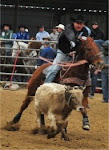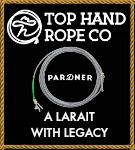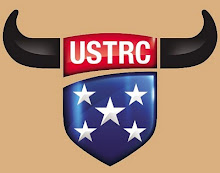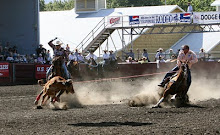skip to main |
skip to sidebar
Pushing the barrier – November 2015
If you’ve ever had to replace a heel horse, you know how difficult it
can be to find a horse you can get along with; especially if you’ve been
riding the same horse for quite a while. I’m always amazed, when
watching my clients, at how intelligent horses really are. I see so many
heelers that never engage their reins, yet the horse figures out the
cue of when he needs to stop. This is an unspoken, and often
unintentional, cue and what makes the horse so hard to replace.
Heeling can be very frustrating because there are so many variables out
of your control. I often show people video where the heeler does
everything correctly and yet misses because the header did not do their
job correctly. It can cause a heeler to lose a lot of sleep and without
watching it on video, it’s difficult to detect.
When watching heelers who come for lessons, it doesn’t take long to
figure out which speed they rope the dummy. If you rope the dummy going
slow all the time, you tend to stop early and then throw. Then when you
get on fast steers, you struggle to keep the legs in your loop and get a
dally. All because you stop your horse early and he’s standing still
when your rope goes on the legs and your rope is speeding up as it’s
leaving your left hand.
It’s very important to learn to engage your bridle reins, especially
when riding a young or green horse. Currently I’m working on a young
heel horse, Ricky, an ex-Reiner who is scared to death of cows. Recently
I’ve finished a six-part video series with Ricky about heeling on a
horse that stops with his head down and the effects of that habit.
A heel run is an equation where the speed of your swing, how fast your
horse is moving, and how fast the steer is moving are all related. The
answer to that equation determines when to engage your reins. If a horse
is stopping correctly, it’s easy to put your rope on the ground. If he
is not stopping correctly, it’s very difficult.
What’s new with me: We are getting ready for the USTRC Finals. I’m
trying to take some time to practice for myself and get my horses ready.
This week Jake Long, Wesley Thorp, Steve Northcott, and Shay Carroll
practiced at the house. I’ve loaded all those sessions on speedroping.com for viewing.
Jennifer and Hali both roped well at the World Series in Stephenville
this weekend. Jennifer won the #12 and Hali placed twice in the #10.
Hali and Gabe are both playing select ball and we have tournaments every
weekend.
Be sure and check out my six-part series showing Ricky that includes
stopping during the heel run and why it’s so hard to replace a heel
horse.
The Struggles of Heelers
The fact is it’s difficult to improve without consistent practice and
for heelers, that means having good, consistent handles of their steers.
The best practice tool is a machine where you can work on your
position, corner, and target. I prefer the Hot Heels because the legs
move so that you must be in time to catch. However, when roping steers
behind lower numbered headers, it’s very difficult to get consistent
turns.
The handle is the responsibility of the header and if done correctly,
gives his partner the best chance to catch the steer. There are times
when I cause my heeler to miss. If I’m riding a young or green horse,
often I’ll turn the steer’s head loose while working on my horse’s
footing. This breaks the stride of the steer and causes the heeler’s
timing to get out of sync.
Believe me headers, the last thing I want to do is give ammunition to
heelers who like to blame their headers. But the truth is if the steer
isn’t handled correctly, it’s usually the header’s fault, at any level.
This is not uncommon when someone is riding a green or new horse, and
they don’t have control of their horse’s footwork.
Many times headers come to my house for lessons and tell me that people
can’t catch behind them. Often they think their partners are trying too
hard. Then we film and watch the video to figure out why their heelers
can’t catch. When you watch a video frame by frame, it exposes the real
reason.
On speedroping.com
I’m currently working on a series of drills for headers and their
horses. Currently we’re on Drill #11 which is about getting a head horse
to do his footwork correctly. It shows the importance of where your
feet are and what they need to do in order to handle the steer
correctly. It’s not just about the bridle reins. You have to control the
side of the horse as well. If you cannot side pass and move your horse
around, you’re going to have a difficult time handling steers correctly.
What’s new with me: Gabe is playing select baseball on a team in
Granbury. Hali is playing select ball on a 14 & under team and she’s
just 11. They are still roping but they enjoy playing ball while
getting stronger and understanding competing. I think it’s important for
them to learn the mental aspects of playing sports. Gabe has been
turning steers. Hali has been roping at jackpots and will be competing
in Stephenville soon.
The ERA rodeos start in March of 2016, so it looks like I’ll be coming
out of retirement. For information on ERA rodeos, you can find a link to
it on speedroping.com.
Pushing the Barrier by Speed Williams – August 2015
Heading Loops that Catch
Lately the headers coming to my place have had questions about where to swing their loop, at what angle, and where their tip should point. A lot of headers watch reachers rope and see them swinging their rope with the tip pointed two or three feet over the horns. This works, in this case, because the combination of distance and gravity allows the loop to reach the target. This particular swing does not work well when running close.
I want to talk about running close and being able to catch every cow. This is totally different than reaching. I’m talking about riding your horse to the cow, swinging your rope and being able to deliver your rope right out of your swing. When doing this, if you swing over top of the horns and come across the horns, without changing the angle of your swing to throw, your odds of catching increase dramatically.
It just doesn’t make sense to swing three feet above your target and at the last minute, throw it down. Your odds of success when doing this are not very good.
When playing pool, advanced players use “English” to get control of the cue ball. In roping, when you swing below the horns and then raise your rope to throw it, there will be a lot of action on your rope. The problem is if you don’t have a lot of control, you will often split the horns.
Being able to catch every cow is especially handy when you’re high team. Your heart is pounding and all you have to do is catch. That’s when it’s crucial to ride to position and come out of your swing and rope the horns. Many people struggle with this because they think they need to have action on their rope, but roping out of your swing is much more consistent. Once you can catch every cow, then you can be concerned with action. Like in pool, you first have to learn to make the shot before worrying about putting English on the cue ball.
On speedroping.com there are some videos where I discuss in detail swinging left to right versus roping both horns at the same time. If you’re only willing to learn to rope one way, then you will be unable to overcome the obstacles that invariably come during competition. I’ve seen this in high numbered headers who love to reach. When all they have to do is catch, they miss and split the horns because they didn’t learn to run close and catch. If you miss your high team steer, your partner will not be happy.
What’s new with me: Lately I’ve been riding a horse that was trained as a Reiner. As such he’s got some bad habits in the roping pen I’ve been working on. He tends to run with his nose inside, won’t lock on the cow, and stops with his head down. However, he’s very broke and has a lot of buttons. We have some videos of me riding him and looking like a monkey riding a border collie.
My kids are in the middle of baseball and softball. Hali was picked up by the first place team and they are headed to state. Gabe and his team are undefeated this year and headed to district. We’ve been having baseball and softball camp every morning. We film the kids and then have them watch themselves on video. I hired a sixteen-year-old softball player so I could film her and have our girls watch their film and hers simultaneously. It’s very much like roping where little things make a big difference.


































